ACCT20074 Contemporary Accounting: Financial Reporting & Analysis
VerifiedAdded on 2023/03/31
|25
|4251
|407
Report
AI Summary
This report provides a detailed analysis of contemporary accounting theory, focusing on the conceptual framework for financial reporting and sustainability reporting practices. It includes a literature review of the history and development of the conceptual framework, addressing concerns within the Australian accounting profession regarding the application of IFRSs and IASs. The report also examines the practical application of the conceptual framework within Santos Limited, an Australian energy company, assessing its compliance with accounting standards and integrated reporting practices. Furthermore, it compares sustainability reporting under different frameworks and appraises a practical entity’s integrated reporting, concluding with insights on improving financial reporting quality and comparability. Desklib provides students access to this assignment and a wealth of other resources including past papers and solved assignments.
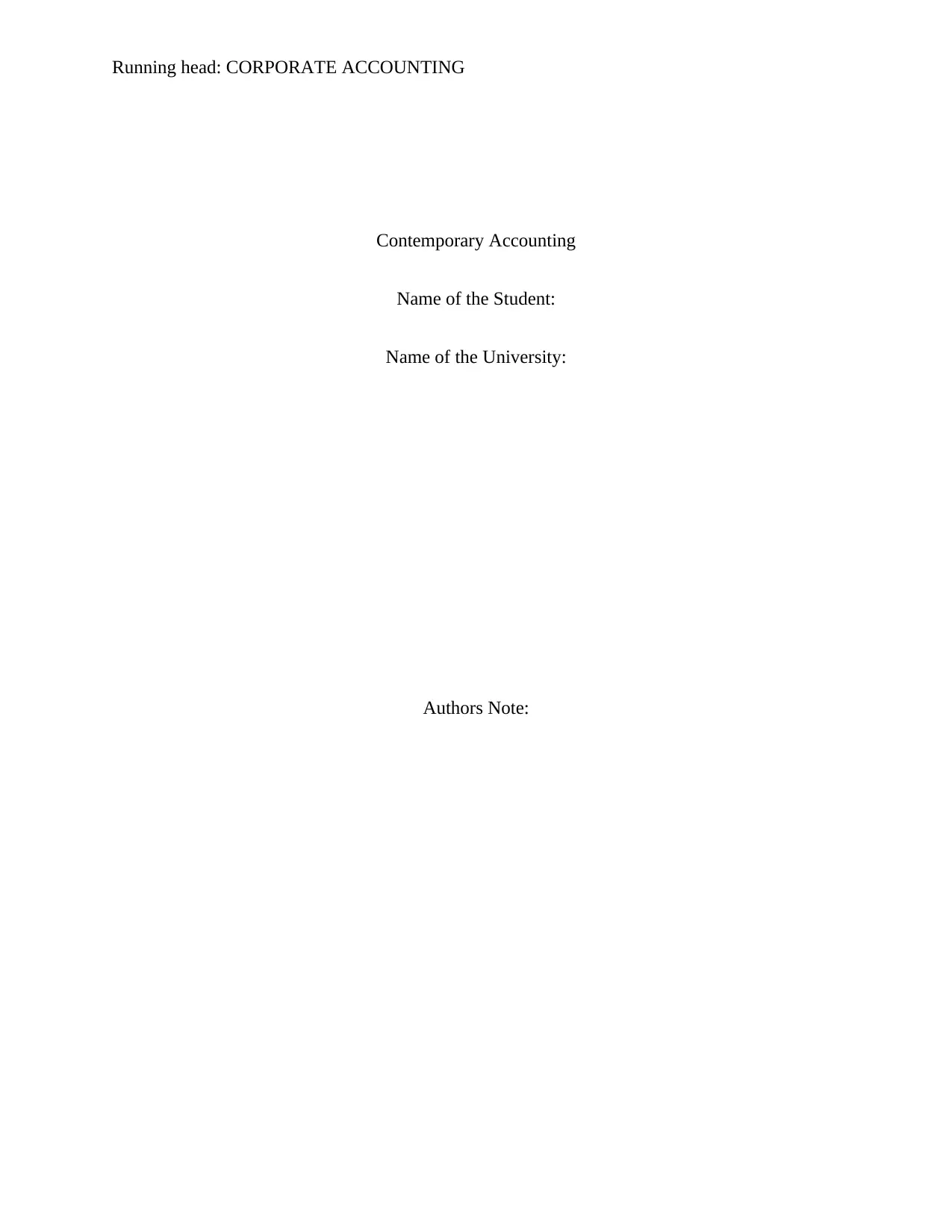
Running head: CORPORATE ACCOUNTING
Contemporary Accounting
Name of the Student:
Name of the University:
Authors Note:
Contemporary Accounting
Name of the Student:
Name of the University:
Authors Note:
Paraphrase This Document
Need a fresh take? Get an instant paraphrase of this document with our AI Paraphraser
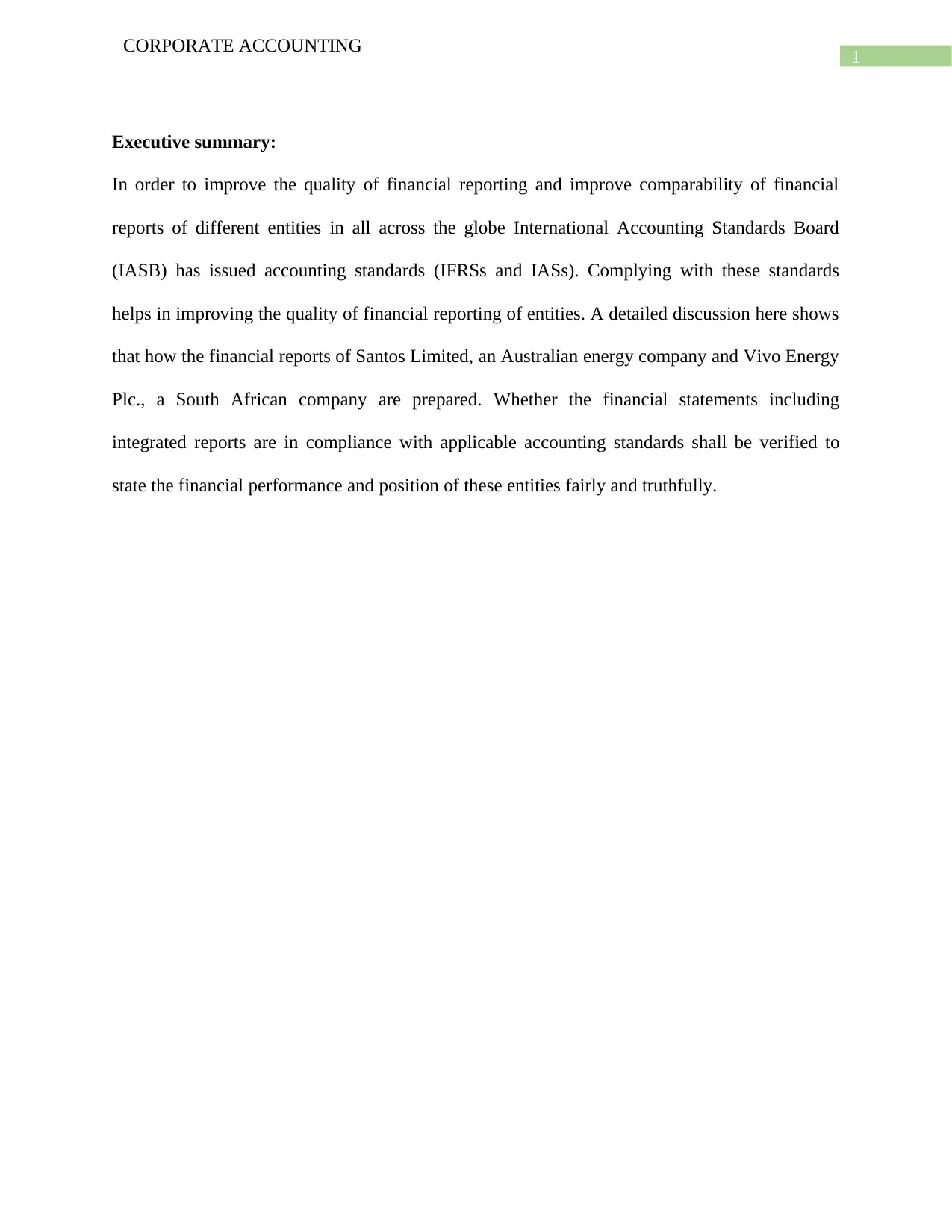
1
CORPORATE ACCOUNTING
Executive summary:
In order to improve the quality of financial reporting and improve comparability of financial
reports of different entities in all across the globe International Accounting Standards Board
(IASB) has issued accounting standards (IFRSs and IASs). Complying with these standards
helps in improving the quality of financial reporting of entities. A detailed discussion here shows
that how the financial reports of Santos Limited, an Australian energy company and Vivo Energy
Plc., a South African company are prepared. Whether the financial statements including
integrated reports are in compliance with applicable accounting standards shall be verified to
state the financial performance and position of these entities fairly and truthfully.
CORPORATE ACCOUNTING
Executive summary:
In order to improve the quality of financial reporting and improve comparability of financial
reports of different entities in all across the globe International Accounting Standards Board
(IASB) has issued accounting standards (IFRSs and IASs). Complying with these standards
helps in improving the quality of financial reporting of entities. A detailed discussion here shows
that how the financial reports of Santos Limited, an Australian energy company and Vivo Energy
Plc., a South African company are prepared. Whether the financial statements including
integrated reports are in compliance with applicable accounting standards shall be verified to
state the financial performance and position of these entities fairly and truthfully.
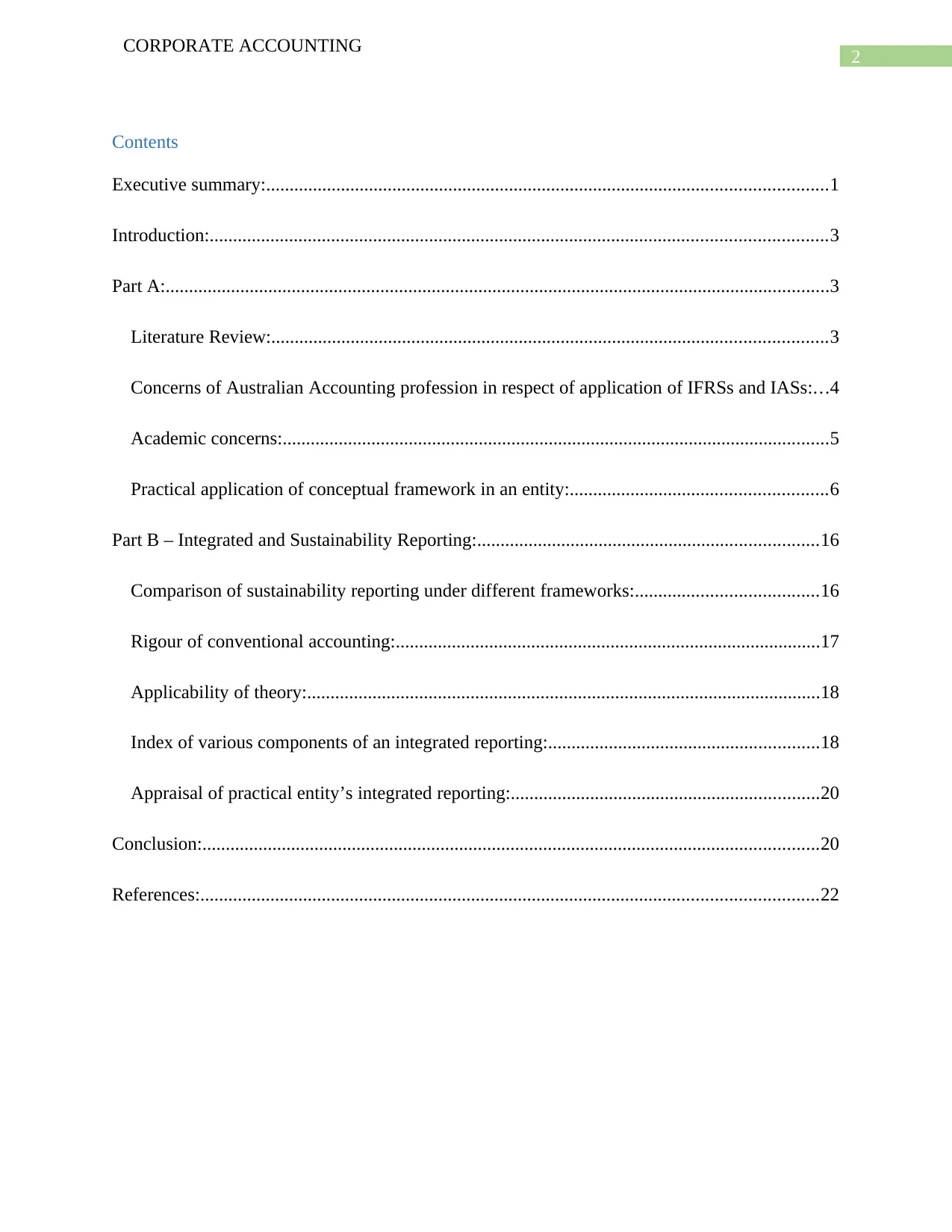
2
CORPORATE ACCOUNTING
Contents
Executive summary:........................................................................................................................1
Introduction:....................................................................................................................................3
Part A:..............................................................................................................................................3
Literature Review:.......................................................................................................................3
Concerns of Australian Accounting profession in respect of application of IFRSs and IASs:...4
Academic concerns:.....................................................................................................................5
Practical application of conceptual framework in an entity:.......................................................6
Part B – Integrated and Sustainability Reporting:.........................................................................16
Comparison of sustainability reporting under different frameworks:.......................................16
Rigour of conventional accounting:...........................................................................................17
Applicability of theory:..............................................................................................................18
Index of various components of an integrated reporting:..........................................................18
Appraisal of practical entity’s integrated reporting:..................................................................20
Conclusion:....................................................................................................................................20
References:....................................................................................................................................22
CORPORATE ACCOUNTING
Contents
Executive summary:........................................................................................................................1
Introduction:....................................................................................................................................3
Part A:..............................................................................................................................................3
Literature Review:.......................................................................................................................3
Concerns of Australian Accounting profession in respect of application of IFRSs and IASs:...4
Academic concerns:.....................................................................................................................5
Practical application of conceptual framework in an entity:.......................................................6
Part B – Integrated and Sustainability Reporting:.........................................................................16
Comparison of sustainability reporting under different frameworks:.......................................16
Rigour of conventional accounting:...........................................................................................17
Applicability of theory:..............................................................................................................18
Index of various components of an integrated reporting:..........................................................18
Appraisal of practical entity’s integrated reporting:..................................................................20
Conclusion:....................................................................................................................................20
References:....................................................................................................................................22
⊘ This is a preview!⊘
Do you want full access?
Subscribe today to unlock all pages.

Trusted by 1+ million students worldwide
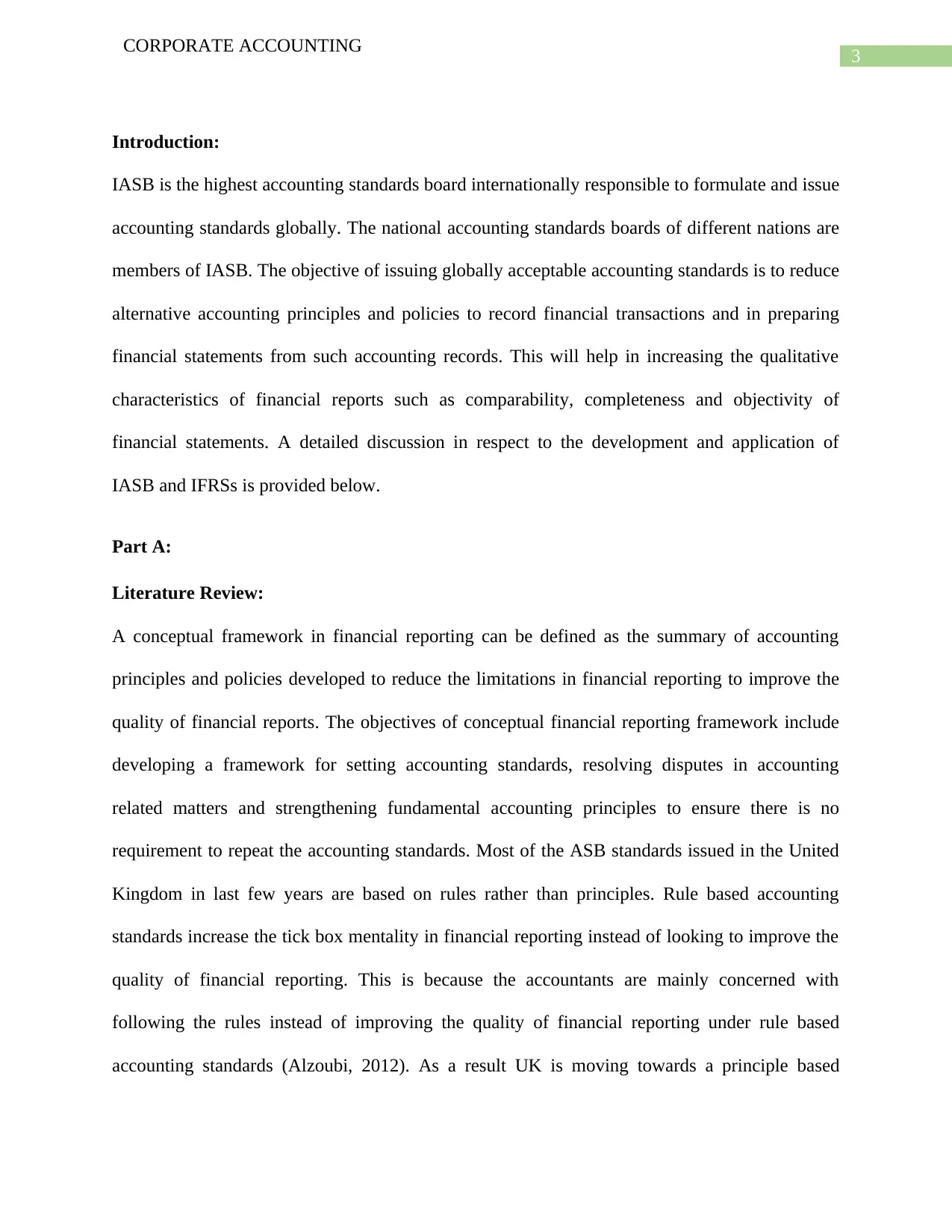
3
CORPORATE ACCOUNTING
Introduction:
IASB is the highest accounting standards board internationally responsible to formulate and issue
accounting standards globally. The national accounting standards boards of different nations are
members of IASB. The objective of issuing globally acceptable accounting standards is to reduce
alternative accounting principles and policies to record financial transactions and in preparing
financial statements from such accounting records. This will help in increasing the qualitative
characteristics of financial reports such as comparability, completeness and objectivity of
financial statements. A detailed discussion in respect to the development and application of
IASB and IFRSs is provided below.
Part A:
Literature Review:
A conceptual framework in financial reporting can be defined as the summary of accounting
principles and policies developed to reduce the limitations in financial reporting to improve the
quality of financial reports. The objectives of conceptual financial reporting framework include
developing a framework for setting accounting standards, resolving disputes in accounting
related matters and strengthening fundamental accounting principles to ensure there is no
requirement to repeat the accounting standards. Most of the ASB standards issued in the United
Kingdom in last few years are based on rules rather than principles. Rule based accounting
standards increase the tick box mentality in financial reporting instead of looking to improve the
quality of financial reporting. This is because the accountants are mainly concerned with
following the rules instead of improving the quality of financial reporting under rule based
accounting standards (Alzoubi, 2012). As a result UK is moving towards a principle based
CORPORATE ACCOUNTING
Introduction:
IASB is the highest accounting standards board internationally responsible to formulate and issue
accounting standards globally. The national accounting standards boards of different nations are
members of IASB. The objective of issuing globally acceptable accounting standards is to reduce
alternative accounting principles and policies to record financial transactions and in preparing
financial statements from such accounting records. This will help in increasing the qualitative
characteristics of financial reports such as comparability, completeness and objectivity of
financial statements. A detailed discussion in respect to the development and application of
IASB and IFRSs is provided below.
Part A:
Literature Review:
A conceptual framework in financial reporting can be defined as the summary of accounting
principles and policies developed to reduce the limitations in financial reporting to improve the
quality of financial reports. The objectives of conceptual financial reporting framework include
developing a framework for setting accounting standards, resolving disputes in accounting
related matters and strengthening fundamental accounting principles to ensure there is no
requirement to repeat the accounting standards. Most of the ASB standards issued in the United
Kingdom in last few years are based on rules rather than principles. Rule based accounting
standards increase the tick box mentality in financial reporting instead of looking to improve the
quality of financial reporting. This is because the accountants are mainly concerned with
following the rules instead of improving the quality of financial reporting under rule based
accounting standards (Alzoubi, 2012). As a result UK is moving towards a principle based
Paraphrase This Document
Need a fresh take? Get an instant paraphrase of this document with our AI Paraphraser
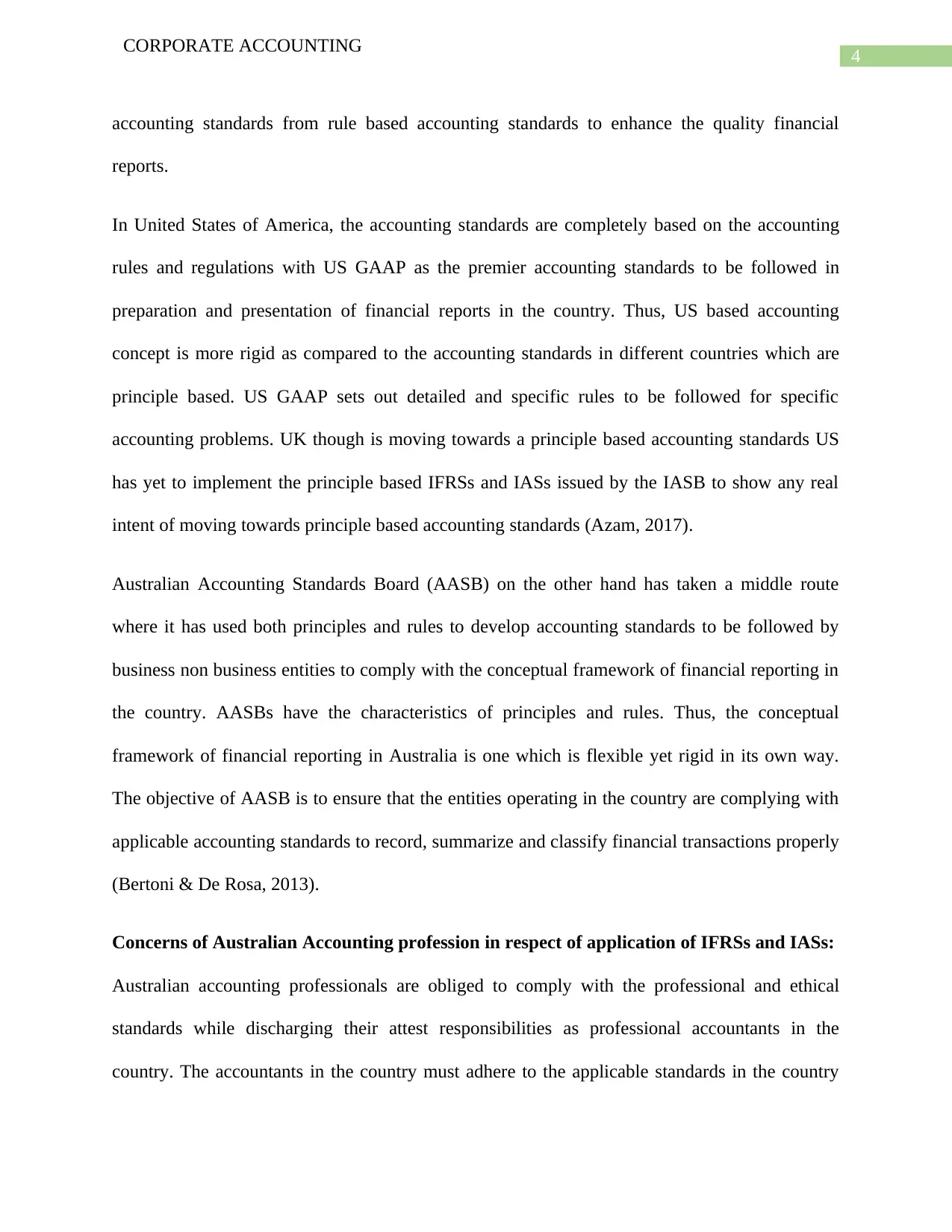
4
CORPORATE ACCOUNTING
accounting standards from rule based accounting standards to enhance the quality financial
reports.
In United States of America, the accounting standards are completely based on the accounting
rules and regulations with US GAAP as the premier accounting standards to be followed in
preparation and presentation of financial reports in the country. Thus, US based accounting
concept is more rigid as compared to the accounting standards in different countries which are
principle based. US GAAP sets out detailed and specific rules to be followed for specific
accounting problems. UK though is moving towards a principle based accounting standards US
has yet to implement the principle based IFRSs and IASs issued by the IASB to show any real
intent of moving towards principle based accounting standards (Azam, 2017).
Australian Accounting Standards Board (AASB) on the other hand has taken a middle route
where it has used both principles and rules to develop accounting standards to be followed by
business non business entities to comply with the conceptual framework of financial reporting in
the country. AASBs have the characteristics of principles and rules. Thus, the conceptual
framework of financial reporting in Australia is one which is flexible yet rigid in its own way.
The objective of AASB is to ensure that the entities operating in the country are complying with
applicable accounting standards to record, summarize and classify financial transactions properly
(Bertoni & De Rosa, 2013).
Concerns of Australian Accounting profession in respect of application of IFRSs and IASs:
Australian accounting professionals are obliged to comply with the professional and ethical
standards while discharging their attest responsibilities as professional accountants in the
country. The accountants in the country must adhere to the applicable standards in the country
CORPORATE ACCOUNTING
accounting standards from rule based accounting standards to enhance the quality financial
reports.
In United States of America, the accounting standards are completely based on the accounting
rules and regulations with US GAAP as the premier accounting standards to be followed in
preparation and presentation of financial reports in the country. Thus, US based accounting
concept is more rigid as compared to the accounting standards in different countries which are
principle based. US GAAP sets out detailed and specific rules to be followed for specific
accounting problems. UK though is moving towards a principle based accounting standards US
has yet to implement the principle based IFRSs and IASs issued by the IASB to show any real
intent of moving towards principle based accounting standards (Azam, 2017).
Australian Accounting Standards Board (AASB) on the other hand has taken a middle route
where it has used both principles and rules to develop accounting standards to be followed by
business non business entities to comply with the conceptual framework of financial reporting in
the country. AASBs have the characteristics of principles and rules. Thus, the conceptual
framework of financial reporting in Australia is one which is flexible yet rigid in its own way.
The objective of AASB is to ensure that the entities operating in the country are complying with
applicable accounting standards to record, summarize and classify financial transactions properly
(Bertoni & De Rosa, 2013).
Concerns of Australian Accounting profession in respect of application of IFRSs and IASs:
Australian accounting professionals are obliged to comply with the professional and ethical
standards while discharging their attest responsibilities as professional accountants in the
country. The accountants in the country must adhere to the applicable standards in the country
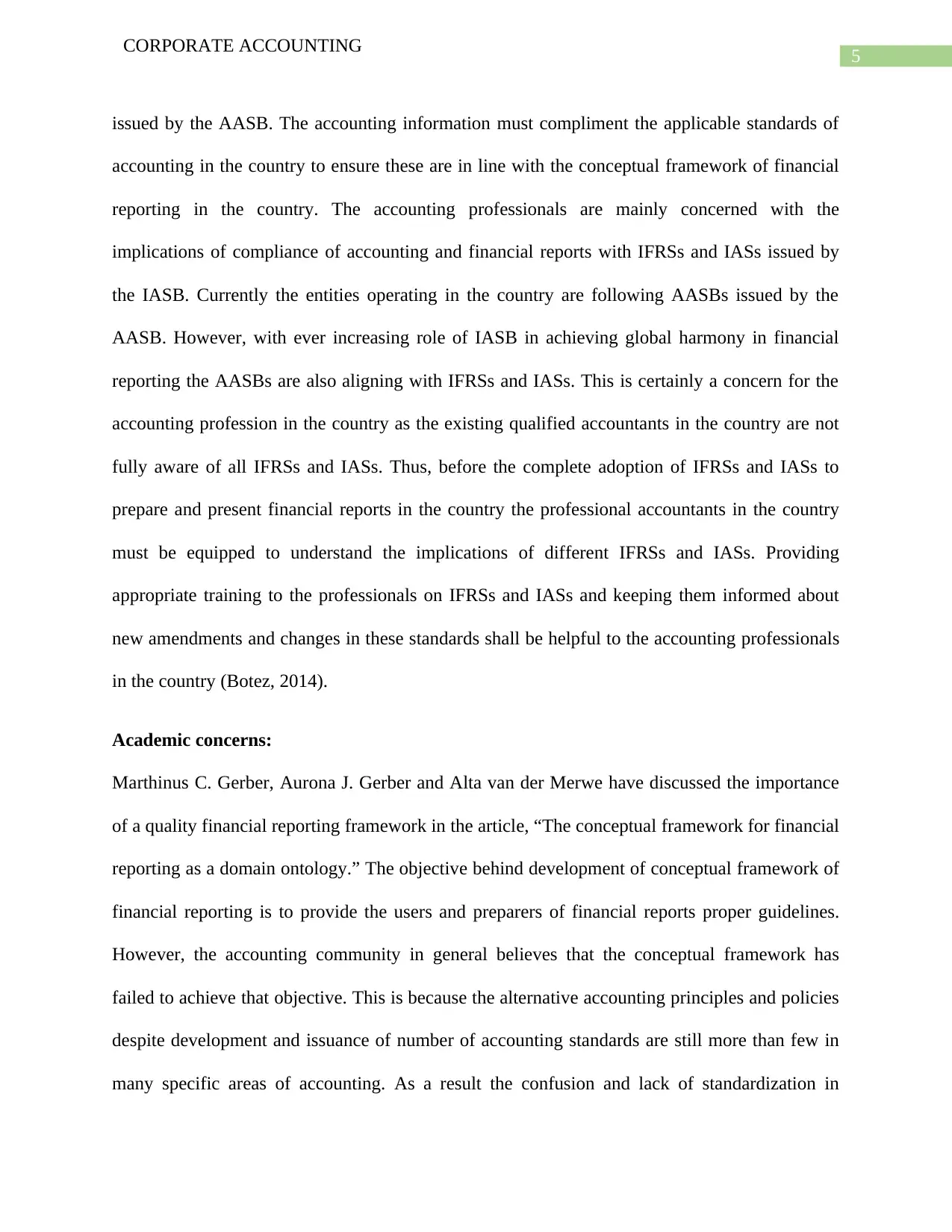
5
CORPORATE ACCOUNTING
issued by the AASB. The accounting information must compliment the applicable standards of
accounting in the country to ensure these are in line with the conceptual framework of financial
reporting in the country. The accounting professionals are mainly concerned with the
implications of compliance of accounting and financial reports with IFRSs and IASs issued by
the IASB. Currently the entities operating in the country are following AASBs issued by the
AASB. However, with ever increasing role of IASB in achieving global harmony in financial
reporting the AASBs are also aligning with IFRSs and IASs. This is certainly a concern for the
accounting profession in the country as the existing qualified accountants in the country are not
fully aware of all IFRSs and IASs. Thus, before the complete adoption of IFRSs and IASs to
prepare and present financial reports in the country the professional accountants in the country
must be equipped to understand the implications of different IFRSs and IASs. Providing
appropriate training to the professionals on IFRSs and IASs and keeping them informed about
new amendments and changes in these standards shall be helpful to the accounting professionals
in the country (Botez, 2014).
Academic concerns:
Marthinus C. Gerber, Aurona J. Gerber and Alta van der Merwe have discussed the importance
of a quality financial reporting framework in the article, “The conceptual framework for financial
reporting as a domain ontology.” The objective behind development of conceptual framework of
financial reporting is to provide the users and preparers of financial reports proper guidelines.
However, the accounting community in general believes that the conceptual framework has
failed to achieve that objective. This is because the alternative accounting principles and policies
despite development and issuance of number of accounting standards are still more than few in
many specific areas of accounting. As a result the confusion and lack of standardization in
CORPORATE ACCOUNTING
issued by the AASB. The accounting information must compliment the applicable standards of
accounting in the country to ensure these are in line with the conceptual framework of financial
reporting in the country. The accounting professionals are mainly concerned with the
implications of compliance of accounting and financial reports with IFRSs and IASs issued by
the IASB. Currently the entities operating in the country are following AASBs issued by the
AASB. However, with ever increasing role of IASB in achieving global harmony in financial
reporting the AASBs are also aligning with IFRSs and IASs. This is certainly a concern for the
accounting profession in the country as the existing qualified accountants in the country are not
fully aware of all IFRSs and IASs. Thus, before the complete adoption of IFRSs and IASs to
prepare and present financial reports in the country the professional accountants in the country
must be equipped to understand the implications of different IFRSs and IASs. Providing
appropriate training to the professionals on IFRSs and IASs and keeping them informed about
new amendments and changes in these standards shall be helpful to the accounting professionals
in the country (Botez, 2014).
Academic concerns:
Marthinus C. Gerber, Aurona J. Gerber and Alta van der Merwe have discussed the importance
of a quality financial reporting framework in the article, “The conceptual framework for financial
reporting as a domain ontology.” The objective behind development of conceptual framework of
financial reporting is to provide the users and preparers of financial reports proper guidelines.
However, the accounting community in general believes that the conceptual framework has
failed to achieve that objective. This is because the alternative accounting principles and policies
despite development and issuance of number of accounting standards are still more than few in
many specific areas of accounting. As a result the confusion and lack of standardization in
⊘ This is a preview!⊘
Do you want full access?
Subscribe today to unlock all pages.

Trusted by 1+ million students worldwide
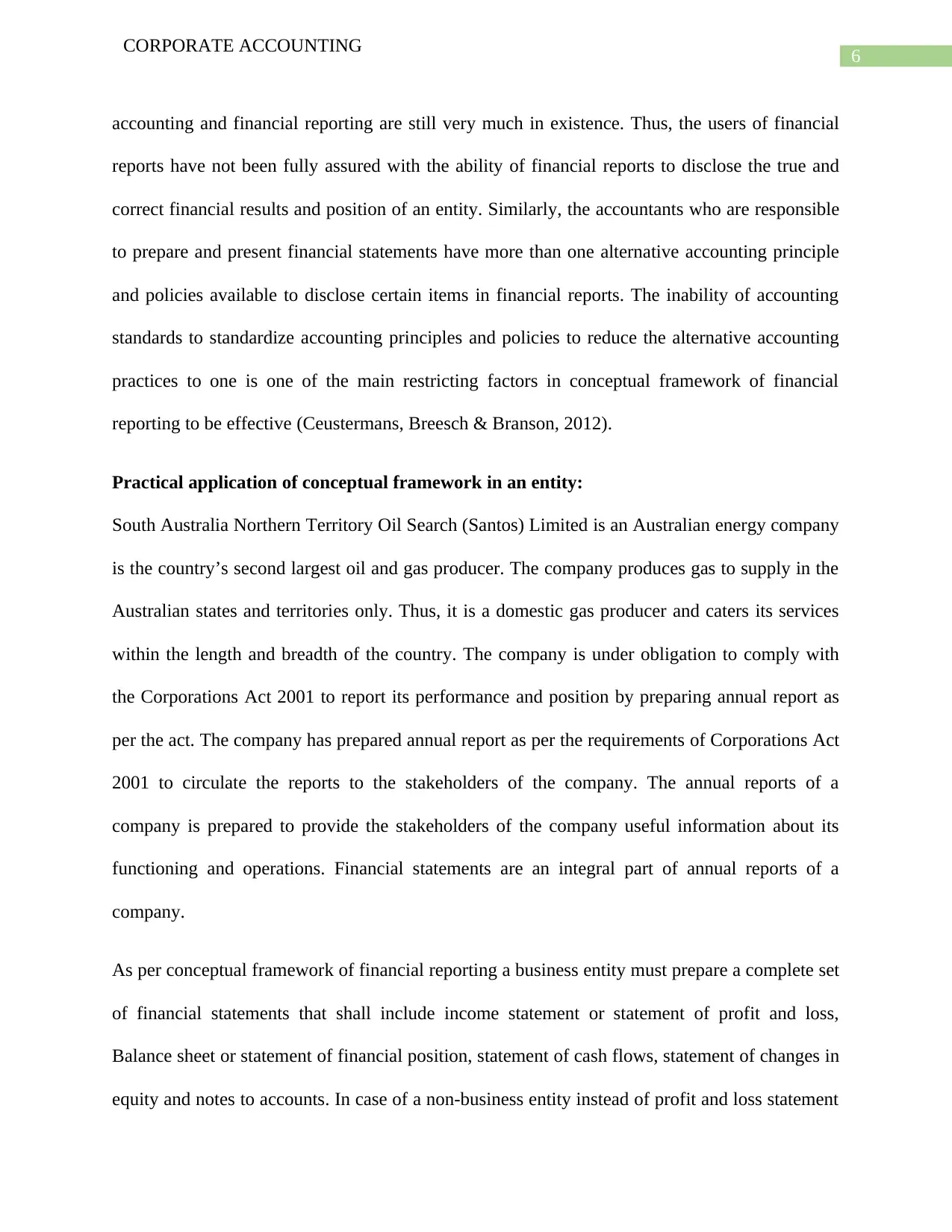
6
CORPORATE ACCOUNTING
accounting and financial reporting are still very much in existence. Thus, the users of financial
reports have not been fully assured with the ability of financial reports to disclose the true and
correct financial results and position of an entity. Similarly, the accountants who are responsible
to prepare and present financial statements have more than one alternative accounting principle
and policies available to disclose certain items in financial reports. The inability of accounting
standards to standardize accounting principles and policies to reduce the alternative accounting
practices to one is one of the main restricting factors in conceptual framework of financial
reporting to be effective (Ceustermans, Breesch & Branson, 2012).
Practical application of conceptual framework in an entity:
South Australia Northern Territory Oil Search (Santos) Limited is an Australian energy company
is the country’s second largest oil and gas producer. The company produces gas to supply in the
Australian states and territories only. Thus, it is a domestic gas producer and caters its services
within the length and breadth of the country. The company is under obligation to comply with
the Corporations Act 2001 to report its performance and position by preparing annual report as
per the act. The company has prepared annual report as per the requirements of Corporations Act
2001 to circulate the reports to the stakeholders of the company. The annual reports of a
company is prepared to provide the stakeholders of the company useful information about its
functioning and operations. Financial statements are an integral part of annual reports of a
company.
As per conceptual framework of financial reporting a business entity must prepare a complete set
of financial statements that shall include income statement or statement of profit and loss,
Balance sheet or statement of financial position, statement of cash flows, statement of changes in
equity and notes to accounts. In case of a non-business entity instead of profit and loss statement
CORPORATE ACCOUNTING
accounting and financial reporting are still very much in existence. Thus, the users of financial
reports have not been fully assured with the ability of financial reports to disclose the true and
correct financial results and position of an entity. Similarly, the accountants who are responsible
to prepare and present financial statements have more than one alternative accounting principle
and policies available to disclose certain items in financial reports. The inability of accounting
standards to standardize accounting principles and policies to reduce the alternative accounting
practices to one is one of the main restricting factors in conceptual framework of financial
reporting to be effective (Ceustermans, Breesch & Branson, 2012).
Practical application of conceptual framework in an entity:
South Australia Northern Territory Oil Search (Santos) Limited is an Australian energy company
is the country’s second largest oil and gas producer. The company produces gas to supply in the
Australian states and territories only. Thus, it is a domestic gas producer and caters its services
within the length and breadth of the country. The company is under obligation to comply with
the Corporations Act 2001 to report its performance and position by preparing annual report as
per the act. The company has prepared annual report as per the requirements of Corporations Act
2001 to circulate the reports to the stakeholders of the company. The annual reports of a
company is prepared to provide the stakeholders of the company useful information about its
functioning and operations. Financial statements are an integral part of annual reports of a
company.
As per conceptual framework of financial reporting a business entity must prepare a complete set
of financial statements that shall include income statement or statement of profit and loss,
Balance sheet or statement of financial position, statement of cash flows, statement of changes in
equity and notes to accounts. In case of a non-business entity instead of profit and loss statement
Paraphrase This Document
Need a fresh take? Get an instant paraphrase of this document with our AI Paraphraser
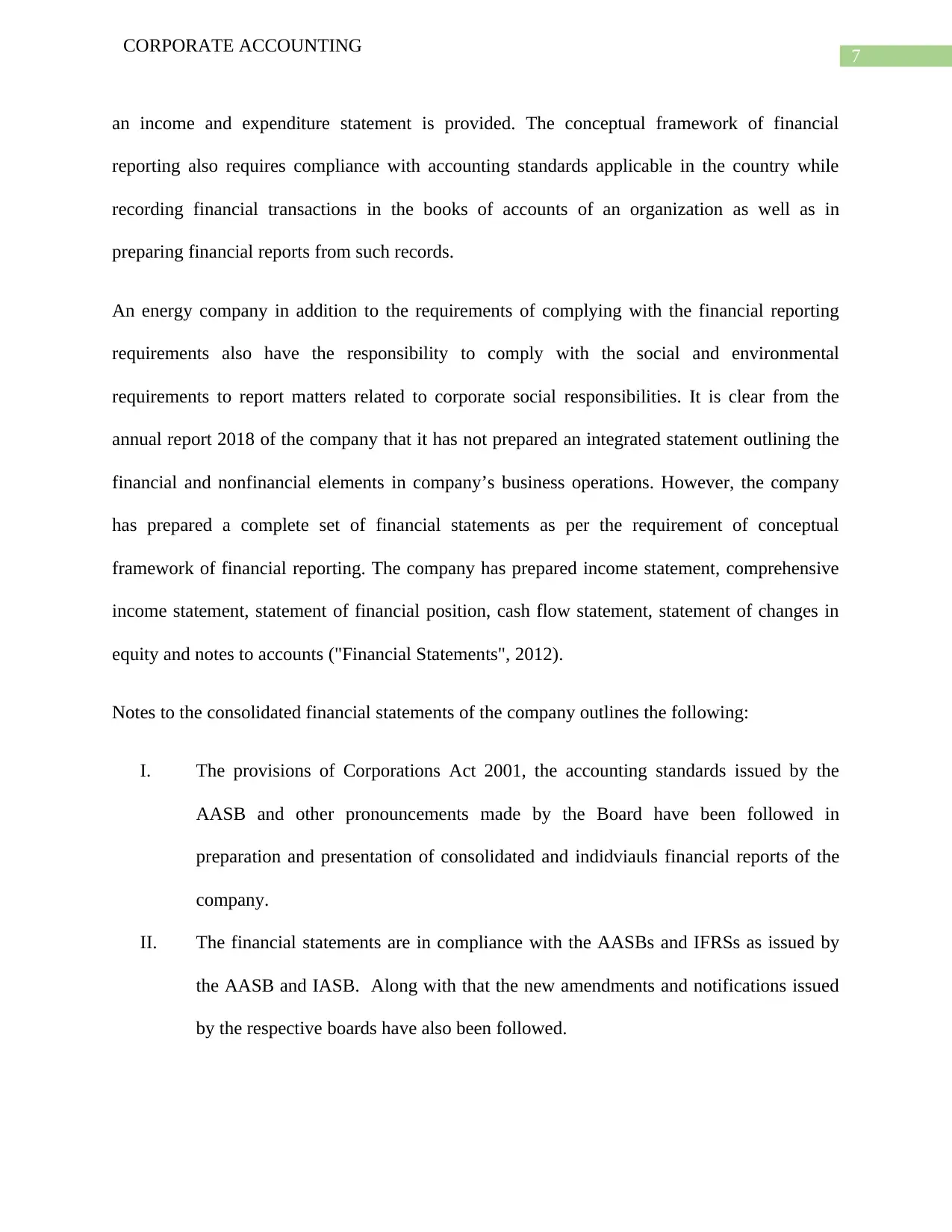
7
CORPORATE ACCOUNTING
an income and expenditure statement is provided. The conceptual framework of financial
reporting also requires compliance with accounting standards applicable in the country while
recording financial transactions in the books of accounts of an organization as well as in
preparing financial reports from such records.
An energy company in addition to the requirements of complying with the financial reporting
requirements also have the responsibility to comply with the social and environmental
requirements to report matters related to corporate social responsibilities. It is clear from the
annual report 2018 of the company that it has not prepared an integrated statement outlining the
financial and nonfinancial elements in company’s business operations. However, the company
has prepared a complete set of financial statements as per the requirement of conceptual
framework of financial reporting. The company has prepared income statement, comprehensive
income statement, statement of financial position, cash flow statement, statement of changes in
equity and notes to accounts ("Financial Statements", 2012).
Notes to the consolidated financial statements of the company outlines the following:
I. The provisions of Corporations Act 2001, the accounting standards issued by the
AASB and other pronouncements made by the Board have been followed in
preparation and presentation of consolidated and indidviauls financial reports of the
company.
II. The financial statements are in compliance with the AASBs and IFRSs as issued by
the AASB and IASB. Along with that the new amendments and notifications issued
by the respective boards have also been followed.
CORPORATE ACCOUNTING
an income and expenditure statement is provided. The conceptual framework of financial
reporting also requires compliance with accounting standards applicable in the country while
recording financial transactions in the books of accounts of an organization as well as in
preparing financial reports from such records.
An energy company in addition to the requirements of complying with the financial reporting
requirements also have the responsibility to comply with the social and environmental
requirements to report matters related to corporate social responsibilities. It is clear from the
annual report 2018 of the company that it has not prepared an integrated statement outlining the
financial and nonfinancial elements in company’s business operations. However, the company
has prepared a complete set of financial statements as per the requirement of conceptual
framework of financial reporting. The company has prepared income statement, comprehensive
income statement, statement of financial position, cash flow statement, statement of changes in
equity and notes to accounts ("Financial Statements", 2012).
Notes to the consolidated financial statements of the company outlines the following:
I. The provisions of Corporations Act 2001, the accounting standards issued by the
AASB and other pronouncements made by the Board have been followed in
preparation and presentation of consolidated and indidviauls financial reports of the
company.
II. The financial statements are in compliance with the AASBs and IFRSs as issued by
the AASB and IASB. Along with that the new amendments and notifications issued
by the respective boards have also been followed.
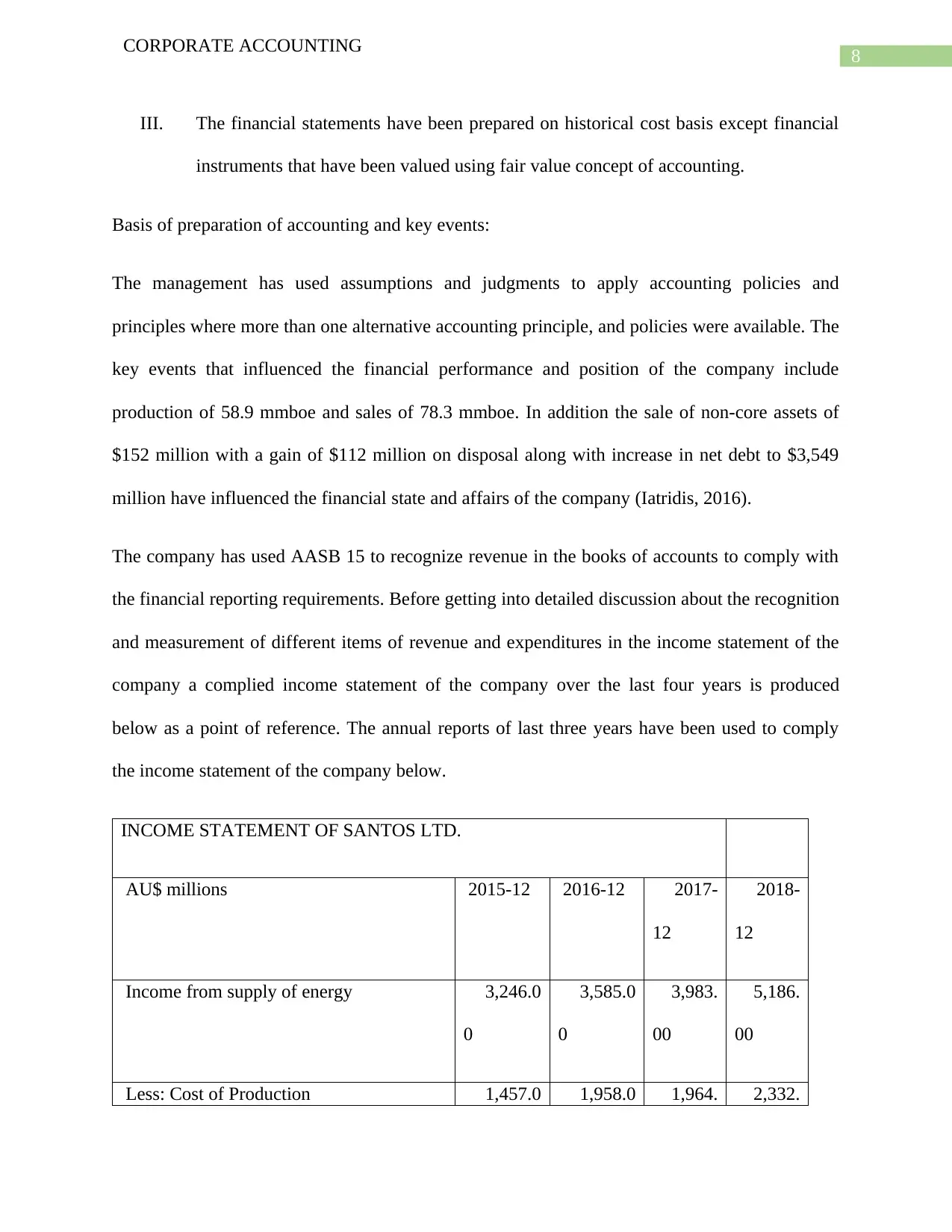
8
CORPORATE ACCOUNTING
III. The financial statements have been prepared on historical cost basis except financial
instruments that have been valued using fair value concept of accounting.
Basis of preparation of accounting and key events:
The management has used assumptions and judgments to apply accounting policies and
principles where more than one alternative accounting principle, and policies were available. The
key events that influenced the financial performance and position of the company include
production of 58.9 mmboe and sales of 78.3 mmboe. In addition the sale of non-core assets of
$152 million with a gain of $112 million on disposal along with increase in net debt to $3,549
million have influenced the financial state and affairs of the company (Iatridis, 2016).
The company has used AASB 15 to recognize revenue in the books of accounts to comply with
the financial reporting requirements. Before getting into detailed discussion about the recognition
and measurement of different items of revenue and expenditures in the income statement of the
company a complied income statement of the company over the last four years is produced
below as a point of reference. The annual reports of last three years have been used to comply
the income statement of the company below.
INCOME STATEMENT OF SANTOS LTD.
AU$ millions 2015-12 2016-12 2017-
12
2018-
12
Income from supply of energy 3,246.0
0
3,585.0
0
3,983.
00
5,186.
00
Less: Cost of Production 1,457.0 1,958.0 1,964. 2,332.
CORPORATE ACCOUNTING
III. The financial statements have been prepared on historical cost basis except financial
instruments that have been valued using fair value concept of accounting.
Basis of preparation of accounting and key events:
The management has used assumptions and judgments to apply accounting policies and
principles where more than one alternative accounting principle, and policies were available. The
key events that influenced the financial performance and position of the company include
production of 58.9 mmboe and sales of 78.3 mmboe. In addition the sale of non-core assets of
$152 million with a gain of $112 million on disposal along with increase in net debt to $3,549
million have influenced the financial state and affairs of the company (Iatridis, 2016).
The company has used AASB 15 to recognize revenue in the books of accounts to comply with
the financial reporting requirements. Before getting into detailed discussion about the recognition
and measurement of different items of revenue and expenditures in the income statement of the
company a complied income statement of the company over the last four years is produced
below as a point of reference. The annual reports of last three years have been used to comply
the income statement of the company below.
INCOME STATEMENT OF SANTOS LTD.
AU$ millions 2015-12 2016-12 2017-
12
2018-
12
Income from supply of energy 3,246.0
0
3,585.0
0
3,983.
00
5,186.
00
Less: Cost of Production 1,457.0 1,958.0 1,964. 2,332.
⊘ This is a preview!⊘
Do you want full access?
Subscribe today to unlock all pages.

Trusted by 1+ million students worldwide
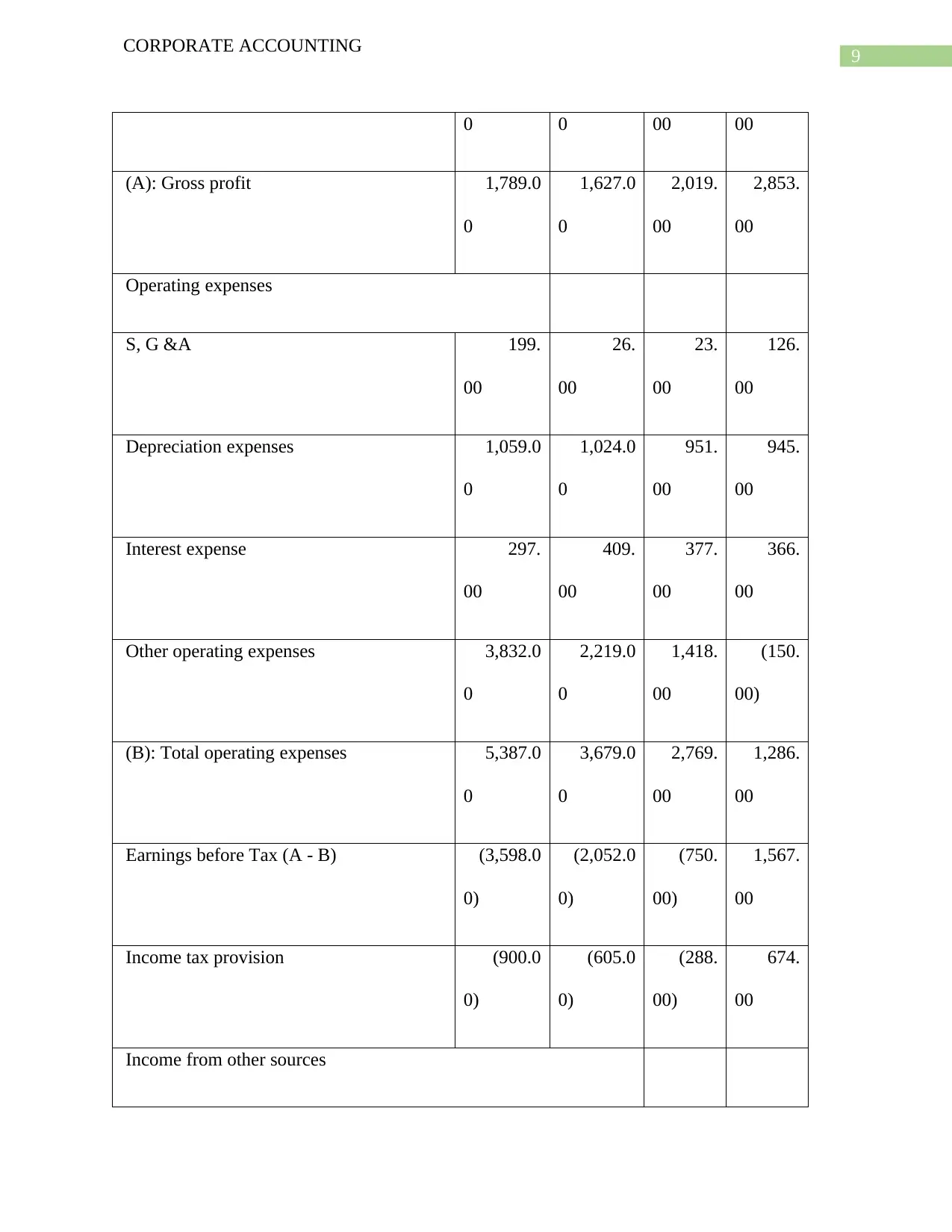
9
CORPORATE ACCOUNTING
0 0 00 00
(A): Gross profit 1,789.0
0
1,627.0
0
2,019.
00
2,853.
00
Operating expenses
S, G &A 199.
00
26.
00
23.
00
126.
00
Depreciation expenses 1,059.0
0
1,024.0
0
951.
00
945.
00
Interest expense 297.
00
409.
00
377.
00
366.
00
Other operating expenses 3,832.0
0
2,219.0
0
1,418.
00
(150.
00)
(B): Total operating expenses 5,387.0
0
3,679.0
0
2,769.
00
1,286.
00
Earnings before Tax (A - B) (3,598.0
0)
(2,052.0
0)
(750.
00)
1,567.
00
Income tax provision (900.0
0)
(605.0
0)
(288.
00)
674.
00
Income from other sources
CORPORATE ACCOUNTING
0 0 00 00
(A): Gross profit 1,789.0
0
1,627.0
0
2,019.
00
2,853.
00
Operating expenses
S, G &A 199.
00
26.
00
23.
00
126.
00
Depreciation expenses 1,059.0
0
1,024.0
0
951.
00
945.
00
Interest expense 297.
00
409.
00
377.
00
366.
00
Other operating expenses 3,832.0
0
2,219.0
0
1,418.
00
(150.
00)
(B): Total operating expenses 5,387.0
0
3,679.0
0
2,769.
00
1,286.
00
Earnings before Tax (A - B) (3,598.0
0)
(2,052.0
0)
(750.
00)
1,567.
00
Income tax provision (900.0
0)
(605.0
0)
(288.
00)
674.
00
Income from other sources
Paraphrase This Document
Need a fresh take? Get an instant paraphrase of this document with our AI Paraphraser
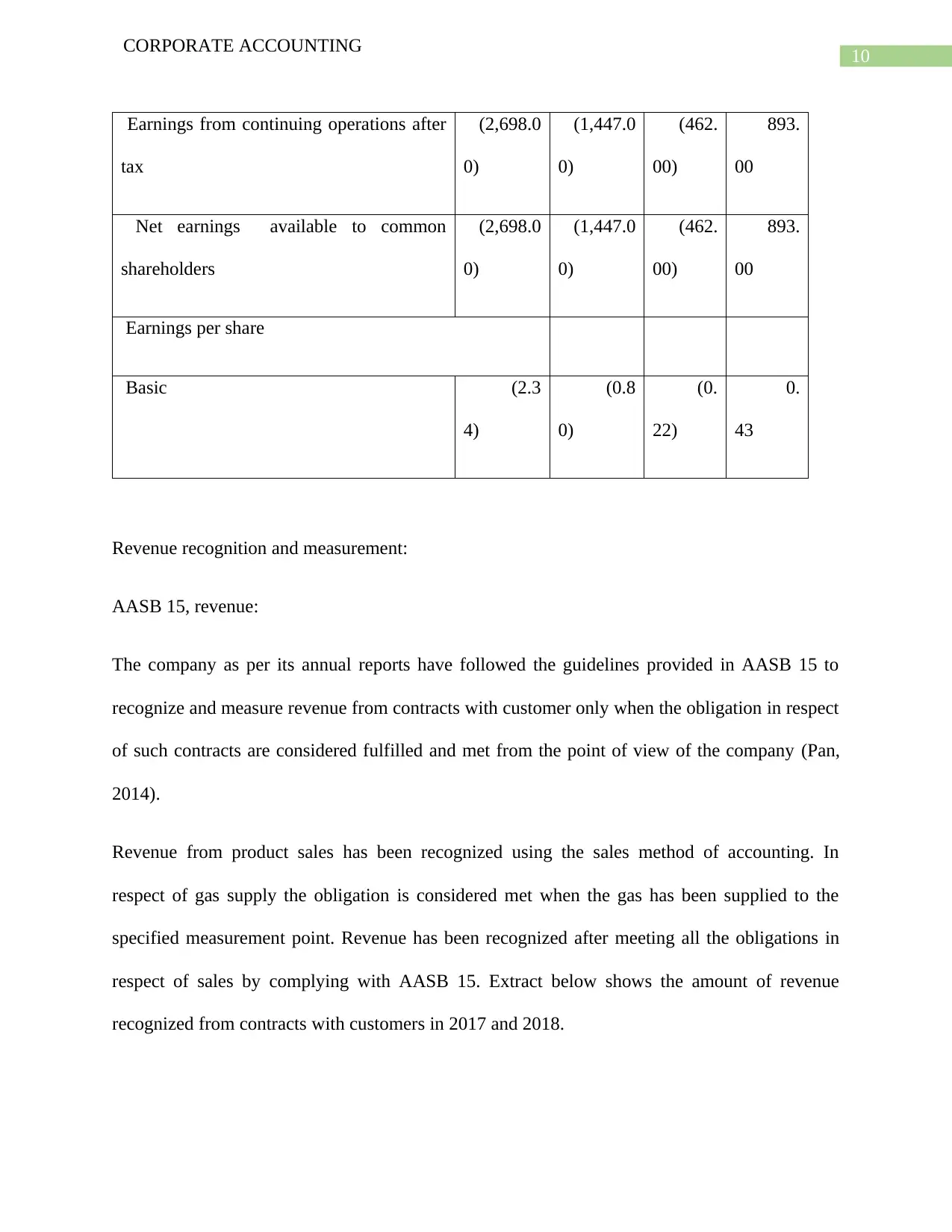
10
CORPORATE ACCOUNTING
Earnings from continuing operations after
tax
(2,698.0
0)
(1,447.0
0)
(462.
00)
893.
00
Net earnings available to common
shareholders
(2,698.0
0)
(1,447.0
0)
(462.
00)
893.
00
Earnings per share
Basic (2.3
4)
(0.8
0)
(0.
22)
0.
43
Revenue recognition and measurement:
AASB 15, revenue:
The company as per its annual reports have followed the guidelines provided in AASB 15 to
recognize and measure revenue from contracts with customer only when the obligation in respect
of such contracts are considered fulfilled and met from the point of view of the company (Pan,
2014).
Revenue from product sales has been recognized using the sales method of accounting. In
respect of gas supply the obligation is considered met when the gas has been supplied to the
specified measurement point. Revenue has been recognized after meeting all the obligations in
respect of sales by complying with AASB 15. Extract below shows the amount of revenue
recognized from contracts with customers in 2017 and 2018.
CORPORATE ACCOUNTING
Earnings from continuing operations after
tax
(2,698.0
0)
(1,447.0
0)
(462.
00)
893.
00
Net earnings available to common
shareholders
(2,698.0
0)
(1,447.0
0)
(462.
00)
893.
00
Earnings per share
Basic (2.3
4)
(0.8
0)
(0.
22)
0.
43
Revenue recognition and measurement:
AASB 15, revenue:
The company as per its annual reports have followed the guidelines provided in AASB 15 to
recognize and measure revenue from contracts with customer only when the obligation in respect
of such contracts are considered fulfilled and met from the point of view of the company (Pan,
2014).
Revenue from product sales has been recognized using the sales method of accounting. In
respect of gas supply the obligation is considered met when the gas has been supplied to the
specified measurement point. Revenue has been recognized after meeting all the obligations in
respect of sales by complying with AASB 15. Extract below shows the amount of revenue
recognized from contracts with customers in 2017 and 2018.
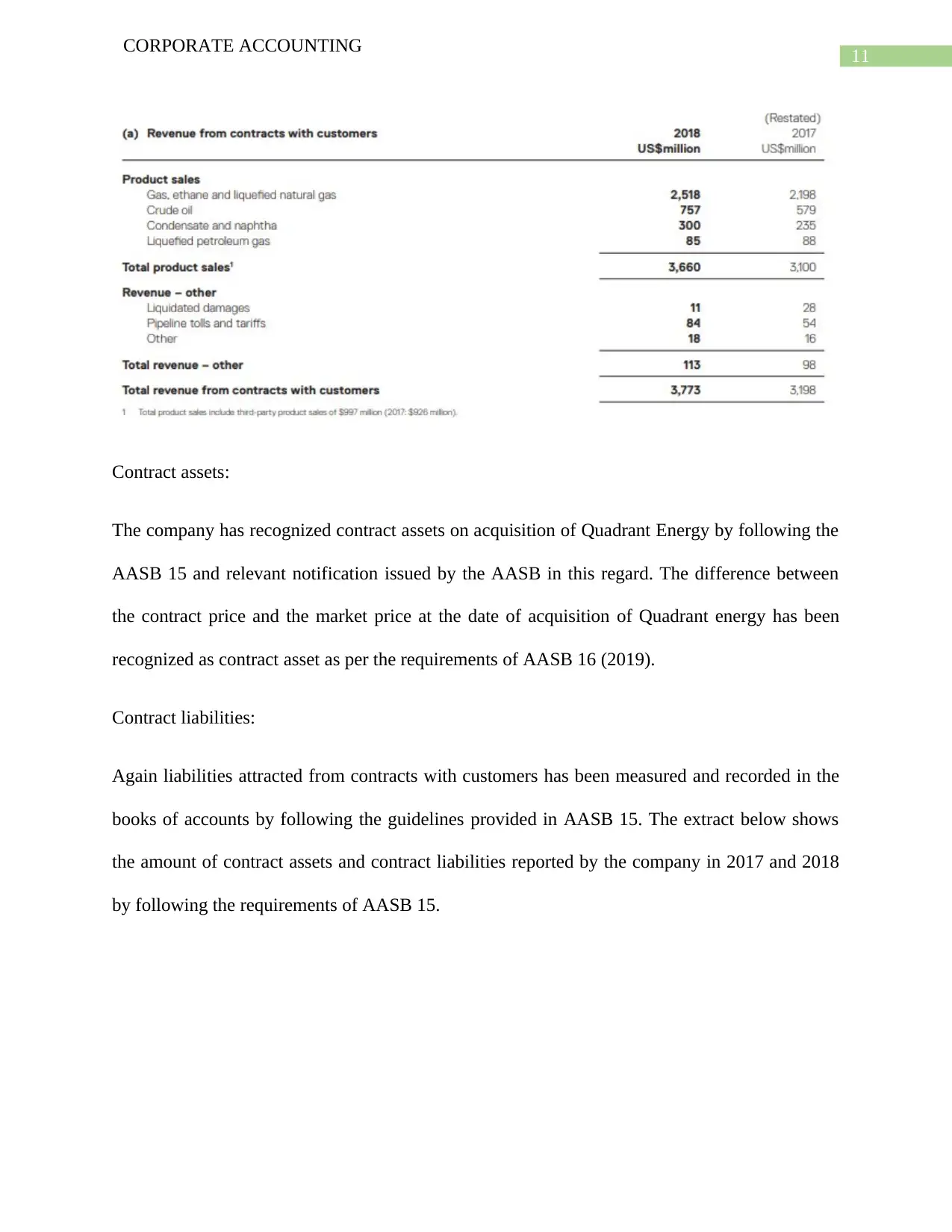
11
CORPORATE ACCOUNTING
Contract assets:
The company has recognized contract assets on acquisition of Quadrant Energy by following the
AASB 15 and relevant notification issued by the AASB in this regard. The difference between
the contract price and the market price at the date of acquisition of Quadrant energy has been
recognized as contract asset as per the requirements of AASB 16 (2019).
Contract liabilities:
Again liabilities attracted from contracts with customers has been measured and recorded in the
books of accounts by following the guidelines provided in AASB 15. The extract below shows
the amount of contract assets and contract liabilities reported by the company in 2017 and 2018
by following the requirements of AASB 15.
CORPORATE ACCOUNTING
Contract assets:
The company has recognized contract assets on acquisition of Quadrant Energy by following the
AASB 15 and relevant notification issued by the AASB in this regard. The difference between
the contract price and the market price at the date of acquisition of Quadrant energy has been
recognized as contract asset as per the requirements of AASB 16 (2019).
Contract liabilities:
Again liabilities attracted from contracts with customers has been measured and recorded in the
books of accounts by following the guidelines provided in AASB 15. The extract below shows
the amount of contract assets and contract liabilities reported by the company in 2017 and 2018
by following the requirements of AASB 15.
⊘ This is a preview!⊘
Do you want full access?
Subscribe today to unlock all pages.

Trusted by 1+ million students worldwide
1 out of 25
Related Documents
Your All-in-One AI-Powered Toolkit for Academic Success.
+13062052269
info@desklib.com
Available 24*7 on WhatsApp / Email
![[object Object]](/_next/static/media/star-bottom.7253800d.svg)
Unlock your academic potential
Copyright © 2020–2025 A2Z Services. All Rights Reserved. Developed and managed by ZUCOL.





